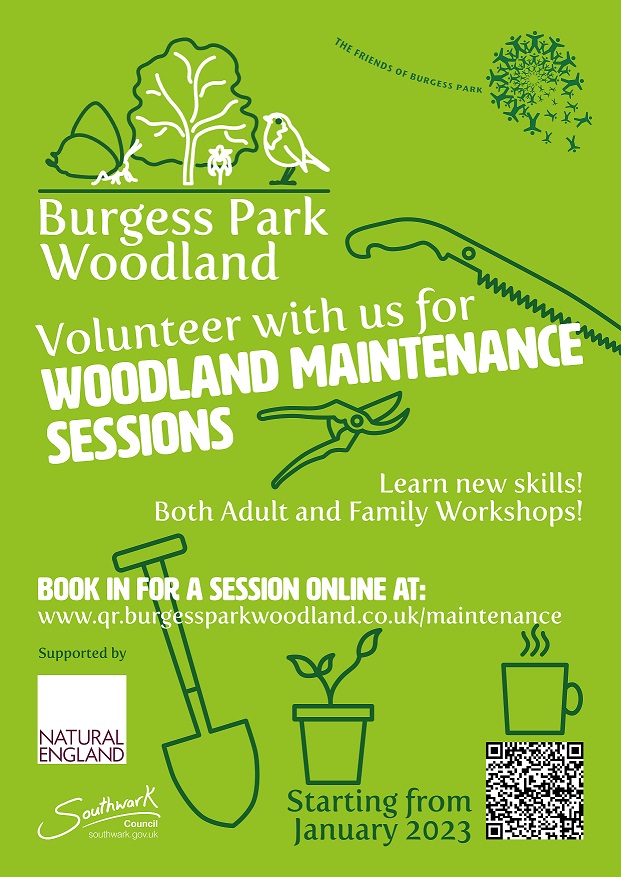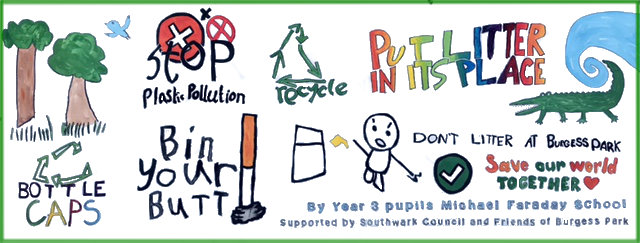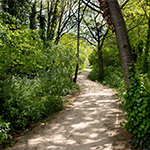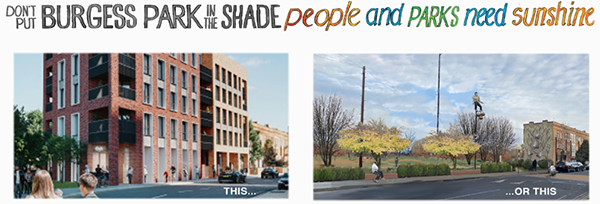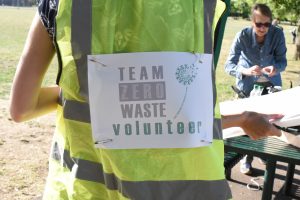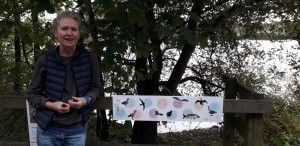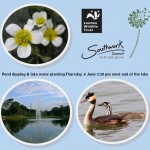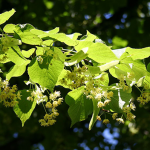Albany Road seed sowing experiment
As described in my previous blog, we have been experimenting with grass cutting in various locations around Burgess Park, to see which wild plants would emerge over time and how much wildlife would be attracted. We will focus on these areas in the next blog, and discuss the best approaches to maintaining meadow areas and what machinery to use. But, before we did any of this, we experimented with a much larger area of short grass between the three west side mounds and Albany Road. The original plan was just to try and reseed the north banks of the nearby mounds themselves with a more attractive range of plants than the ‘weeds’ that had quickly outgrown the original James Hitchmough prairie planting on these newly built slopes. Previous head gardener Oliver Miller had already experimented with sowing certain seeds, and had the greatest success with a mass sowing of Honesty (Lunaria annua), as well as trying out various other plants.
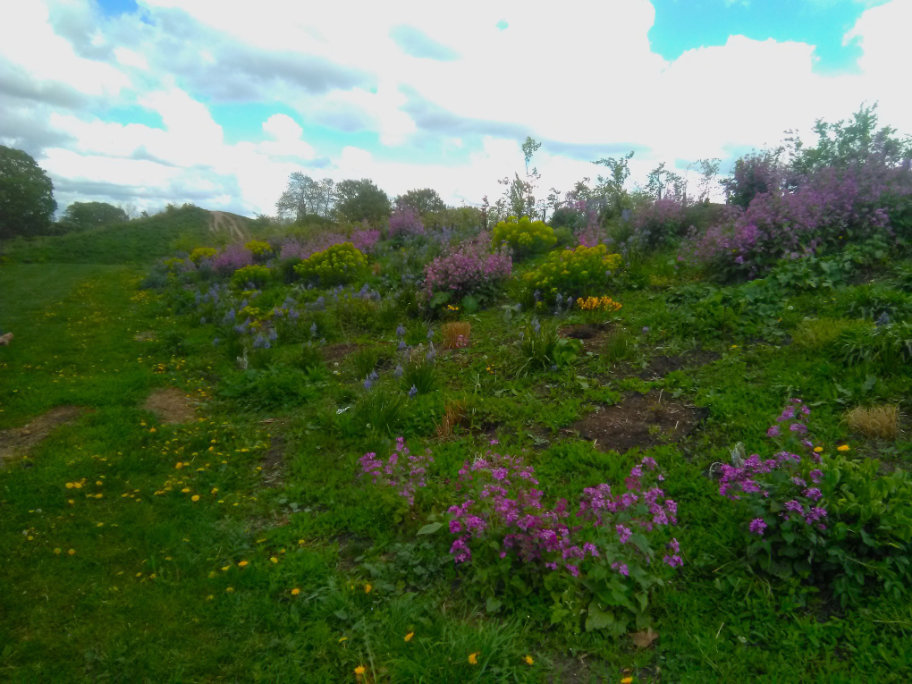
I knew that with the huge seed bank of fast-spreading wild plants already taking over, and with problems with the steepness, dryness and poor soil structure of the bank itself, that any reseeding would have limited success. James Hitchmough kindly visited a few times, and came up with plan to remove all the weeds between the too widely spaced original plants, before a mass sowing of a special cultivar of Deschampsia cespitosa (tufted hair grass) to fill in the gaps with an attractive ornamental grass with sufficient biomass to outcompete all the weeds. This was a clever idea and would have made the banks much more attractive and consistent looking. But I think when James visited, whilst the banks still looked very much in control, probably because we’d just strimmed between all the remaining plants, there was a huge seed bank of weeds already in the soil. The steep banks, with their increasingly thin covering of sugar beet top soil above a harder pan of soil and rubble from the old park, would be a hard location to establish a successfully thick sowing of grass without some kind irrigation and I think, a lot of spraying would have had to be done, along with good luck with the weather. It turns out that we had some very hot and dry periods over the next several years.
We used James’s Deschampsia, but also selected the seed of a much wider variety of native plants as well. I also decided to spread the seed over a much wider area, to strip back, weed and over sow the banks themselves, but also to try and turn the whole space between the slopes and Albany Road into a more natural space, with much more habitat for wildlife.
I wanted to re-contextualise what was seen as an over ambitious prairie slope that had totally failed, and redefine it as a success for wildlife and the park, with the bank becoming a mix of James’s interesting original plants, plus wildflowers and grasses. James, I think, just came up with an excellent plant list for these slopes. The problem was the LDA design was over-ambitious; the banks were too steep and huge to be successfully maintained as designed. A wilder, less intensive approach was more realistic — a new area for habitat and a softer, more attractive space. Rather than an angular triangle of ‘failed’ planting with just short grass at its base, a continuation of wildness from bank to road with grass paths to walk though would make the increasing wildness of the bank itself much more appropriate and suit the space better. I also guess that perhaps there was once a meadow somewhere along this fence line at some point before the park was rebuilt … there are pretty metal butterfly posts in places, a certain distance from the fence, that perhaps defined some wilder area, so it was nice to return the dull lawn to a meadow if that was the case.
Many thanks for the council letting me do this; they could have easily insisted that this reseeding was against our obligations to cut the grass around the mounds short, but instead let me proceed with the experiments as I wished. The council showed patience and understanding to allow this area and the nearby banks to become a much more useful habitat as well as being more sustainable to maintain.


We used a wide range of seeds, starting the flat areas with cornfield annuals for colour in the first few years.
I was interested in how long the cornfield annuals would persist without re-cultivation each year. The answer is about 2-3 years though we still get odd plants germinating where the grass is less thick. The cornfield annuals used were field poppy (Papaver rhoeas), field marigold (Glebionis segetum), cornflower (Centaurea cyanus) and corncockle (Agrostemma githago). I expected these to be the first flowers we saw but nature had other ideas!


Cornfield annuals are one of the main plants we have lost from our countryside meadows and rely on a cycle of yearly plowing to grow alongside crops such as wheat. They are mainly kept in existence these days by various excellent wildflower seed-selling companies. Unfortunately, to keep them growing in our meadows, we would need to re-cultivate the soil every few years and top up the seed. But for several hundred quid spent every few years, we could have a few of these large areas of very colourful and densely spaced flowers, that look more like the ‘ideal’ meadow people desire. In this case, we wanted some initial colour (and I hoped the council would be impressed and allow us to do more cornfield meadows in the future!) and for the cornflowers to give some initial shelter to the perennial wildflowers and grasses that we had also sown. In the foreground, one of Hitchmough’s west-facing banks, designed to look a bit like the meadows of central Europe, with Carthusian dianthus in flower (Dianthus carthusianorum).

As for the rest of the seed, we chose native wildflower and grass seed hopefully suitable for the local conditions, depending on what was affordable and available. Many species I would have liked to have used were either unavailable or unaffordable in sufficient quantities. I would have liked to have used different suppliers to have a broader range of seed, including from the European suppliers Jelitto (https://www.jelitto.com/) but budget constraints meant we went with the excellent Naturescape (https://www.naturescape.co.uk/).
Perhaps a better choice would have been Emorsgate seeds (https://wildseed.co.uk/), simply as they are located closer to London, meaning their seed would be more adapted to local conditions. The wonderful new, low nutrient meadow on the west side used Emorsgate and has a fabulous variety of plants. I unfortunately had no budget to replace all the soil with a low nutrient alternative.
The seed we used included:
Achillea millefolium (yarrow)
Agrimmonia eupatorium (agrimony)
Borago officinalis (borage)
Centaurea nigra (knapweed)
Centaurea scabiosa (greater knapweed)
Daucus carrota (wild carrot)
Dipascus fullonum (teasel)
Gallium album (hedge bedstraw)
Gallium verum (ladies bedstraw)
Hypericum perforatum (perforate St John’s wort)
Leucanthemum vulgare (ox-eye daisy)
Pastinaca sativa (wild parsnip)
Plantago lanceolata (ribwort plantain)
Silene dioica (red campion)
Silene vulgaris (bladder campion)
Reseda lutea (wild mignonette)
Trifolium repens (white clover)
Verbascum nigrum (dark mullein)
Vicia sativa (common vetch)
Clay soil wild grasses mix:
Agrostis capillaris (common bent)
Alopecurus pratensis (meadow foxtail)
Anthoxanthum odoratum (sweet vernal grass)
Briza media (quaking grass)
Cynosurus cristatus (crested dogstail)
Festuca rubra ssp. commutata (Chewing’s fescue)
Festuca rubra ssp litoralis (Slender red fescue)
Hordeum secalinum (meadow barley)
Poa pratensis (smooth stalked meadow grass)
Trisetum flavescens (yellow oat grass)
Festuca ovina (sheep’s fescue)
James Hitchmough’s generously donated Deschampia for the north banks of the mounds
General clay meadow mix 80/20 mix (80% grasses to 20% flowers)
This had a mix of the grasses to the left and the wildlflowers above plus:
Geranium pratense (meadow cranesbill)
Knautia arvensis (field scabious)
Leontodon hispidus (rough hawkbit)
Lathyrus pratensis (meadow vetchling)
Lychnis flos-cuculi (ragged robin)
Primula veris (cowslip)
Prunella vulgaris (self heal)
Rhinanthus minor (yellow rattle)
Rumex acetosa (common sorrel)
Stachys officinalis (betony)
Tragopogon pratensis (goats beard)
Trifolium pratense (red clover)
(very little of this last list actually germinated)
The seed suppliers have developed great knowledge in terms of the ratios of flowers to grasses so their mixes tend to come in 80/20 or 90/10 grass to flower ratios. But we wanted to just throw down as much flower seed as possible, in the hope that more would persist long term. From the results of our sowing, perhaps a simple 80/20 clay wildflower mix would have been more efficient and much cheaper but we hardly spend a fortune. I did, however, find that few of the flowering species in the clay wildflower species mix actually germinated and the individual species seed germinated better. I wish I’d also included large quantities of Lucerne (alfalfa) in the sowing which would have been great for our Holly Blue butterflies, since it is available as a green manure and is very cheap to buy in large quantities but didn’t think to do so at the time. I should have consulted the local wildlife experts before selecting the seed to have identified more species specifically useful to wildlife found in the park.
Also, compare our well-intentioned but inefficient sowing with Hitchmough’s precise work which can still be seen at St George’s prairie and various other slopes and dips around the park. James compiled a vast database of native and non-native species during his work at the University of Sheffield. He would build a vast array of small seed sowing beds, try different mixes and record the exact proportions of different species emerging. From this he would estimate the ideal ratios of a vast range of seed needed in a specific mix from wild herbaceous plants of the world.
In comparison with the precise mixes from the seed suppliers, or James’s very scientific approach, we just bought a load of hopefully suitable seed, threw it down and hoped for the best! This meant that for a further two years we had an impressive amount of flowers. The cornfield annuals faded but with the grass still thin much of the other seed emerged. Certain species such as borage, red and bladder campion, hedge and ladies bedstraw, teasels, wild carrot, St John’s wort, ribwort plantain, knapweed, yarrow, salad burnet, the clay grass mix, lesser amounts of vetch and wild mignonette appeared. The rest of the seed didn’t appear at all. We likely didn’t sow at the correct time for all the species, or conditions weren’t suitable for germination, or perhaps some of the seed in the clay wildflower mix wasn’t so fresh or viable. Unfortunately, the Deschampsia also didn’t emerge on the banks. I think there wasn’t enough moisture for it to establish on the dry banks, and the seed was at least a few years old by the time we used it. There was also too much competition from the massive seed bank of wild plants already present and likely from all the other seed I also added.
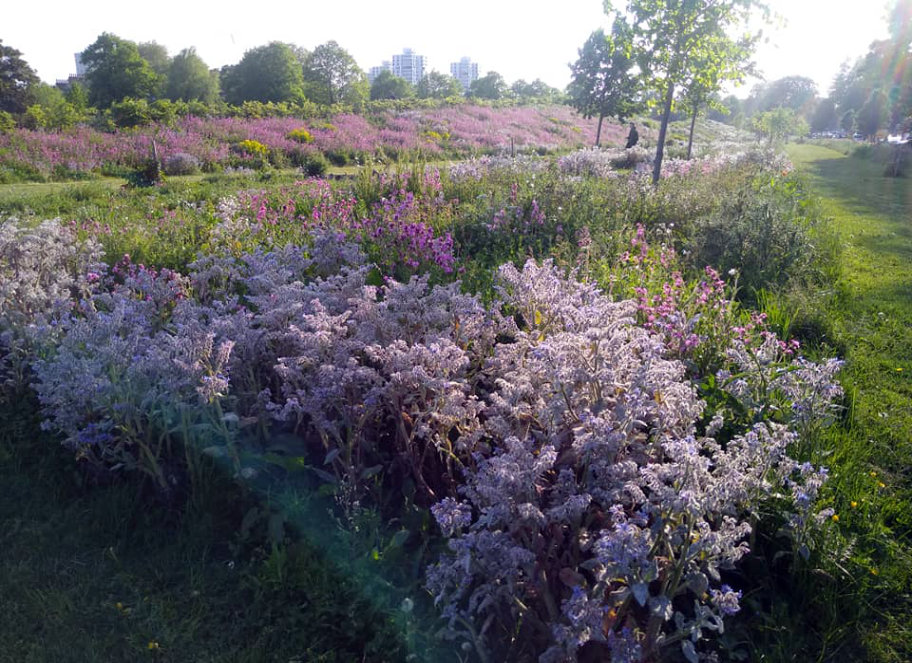
Forward a few more years and the balance of plants has changed again. Now the campion, borage and some of the other sown wildflowers have slowly reduced to the odd plant here and there, rather than a great but rather artificial, wall of colour. The soil and climactic conditions clearly aren’t suitable for large quantities of these plants to persist over time. It was a lovely and colourful experiment but longer term, nature will have its way. Clay soil once firm is not very friable so many seeds can’t get into the soil to germinate, or successfully germinate if they do, and most importantly, the clay soil holds onto nutrients so the grasses thicken up over time giving less space for the flowers, as well as forming a barrier to the seed reaching the soil in the first place. Despite us cutting and raking up much of the hay, the range of plants is slowly reverting back to plants that can handle the compacted but rich and quite heavy soil, that can compete with the thick grass and also that can complete their life cycles despite the incredibly hot and dry summers we increasingly have in London.
The grasses are increasingly thick and varied. I still need to try to identify all the species of grass present, what came up from what was sown, and what has appeared from seed already in the soil or blown in by the wind. My eyesight is increasingly poor and the grasses all look very similar without precise or patient enough identification skills!


We currently have a large amount of flowers and the meadow isn’t too high to problematically block sight lines and, for example, attract too much anti-social behaviour. The soil in this area doesn’t yet have such a high percentage of seed from taller more invasive plants that our more established wild areas in the east of the park have. The various banks of the nearby mounds are also full of wildflowers that can now possibly spread to this new area of meadow. The main one so far is chicory. I was hopeful that some of Hitchmough’s plants from nearby banks would also spread into this area, so, for example, we collected vast quantities of aster seed a few years ago and spread it through the whole area to try to extend the meadow’s flowering season, but none has emerged. Brockwell Bake and ancient wheat expert Andy Forbes also tried to establish a few old varieties of wheat, including one with an attractive, purplish seed head. These patches did great in the first year, but didn’t resow themselves the following year.
But our work isn’t done, nature has further plans for our meadow, and we have reached the most challenging stage of maintenance. Ideally we would like to keep the meadow as it is at this stage, but there are many more vigorous and potentially problematic plants that want to establish and outcompete the plants currently growing.
One particularly significant plant is mallow (Malva sylvestris). This year this species has begun to dominate in places. It has pretty purple flowers, but not a particularly attractive structure once it is fully grown, and it both spreads by roots very quickly to form dense clumps as well as dropping copious seed. This would be difficult to eradicate even by spraying; this plant is here to stay. The only way I can think to control it is to cut down and remove all the seed laden stems once it has finished flowering to limit its further spread. But it is a very useful plant for wildlife (and for people foraging for edible leaves in the park).

But there are a great array of taller and even more problematic plants that want to establish in our meadow and re-seeded banks. These include:
Gallium aparine (cleavers) forms a great mat of foliage over other plants which is hard to remove and looks a mess, though it creates habitat and keeps the soil below moist. We have given up trying to remove this as it comes up en masse in spring, but luckily then withers and completely fades away by early summer.
Calystegia sepium (Hedge bindweed) Most gardeners will be well aware of the joys of trying to control bindweed. It does seem to prefer richer soil and flowerbeds and hasn’t spread so fast on the three north banks as I worried it would, though it is a problem in places, as is Convolvulus arvensis (hedge bindweed). On another north bank next to the car park, we worked incredibly hard to remulch the failing slope and replant densely but after a few years where it looked really good, a great carpet of bindweed spread quickly through the thick mulch and totally ruined our work. We are now trying to work out how to get rid of it without killing everything else.
Urtica dioica (stinging nettle). This is a great wildlife plant and we have allowed large clumps to establish on the slopes for certain butterflies. But now it is also appearing in the flat areas of meadow, making it less attractive, more stingy for humans and potentially outcompeting the plants we have already described. Hopefully, it will be kept in check by the thick grass and many other plants competing for nutrients but it is hard to eradicate.
Cirsium arvense (creeping thistle) Like stinging nettle, this spreads by a great network of roots and is very difficult to kill without herbicide. The roots run deep with this plant. It has formed large, tall clumps in various places along the various slopes and has appeared at the far end of the meadow. It has also established in great clumps in places on the new, low nutrient meadow, due to the roots running deeper than the soil replaced. Again it is used by our wildlife including butterflies, but it’s not very pleasant to try and walk through a great clump of it or to have whole meadows turn to thickets of thistles.
Arctium lappa (greater burdock) Another wonderful wild plant for wildlife and medicinally for us, with an impressive structure, pretty little thistle like flowers and giant leaves with great potential to use as a mulch. But it has the most irritatingly spiky and clingy seed which it produces in massive quantities, a massive root system that is impossible to remove, and can grow two metres high. It emerged in a few places on the second north bank, and quickly became a 50m2 thicket, shading out all the plants below. All we can really do without chemicals is cut it down once it is seeding and remove all the seed and cuttings, ideally using the cuttings as a mulching material elsewhere.
Artemisia vulgaris (mugwort), similar to burdock, another useful medicinal plant with an impressive structure, but also very tall and very quickly spreading into huge clumps.
Rumex obtusifolius (broad leaved dock). Another wonderful plant for wildlife but again, grows very tall and can produce 7,000 seeds on one plant. I like the rusty-coloured stems in autumn, but it is another plant that can grow to head height and quickly outcompete other plants. Again, I think the only solution is to remove enough of the stems before all the seed drops each year.
Conium maculatum (hemlock). Another giant, again useful for pollinators with its copious and attractive white umbel flowers, But a very poisonous plant to us, that will grow into huge tall thickets if not kept in check. Again, all we can do is cut down all the seed laden stems before the seed drops so it doesn’t spread across our new meadow.
Rubus plicatus (wild blackberry / bramble). Bramble is the most difficult plant to deal with in the park though, of course, provides copious fruit for us and wildlife as well as habitat. But one plant can send out multiple giant stems that can each grow several metres in a season. The stem quickly loops back down to the soil. It then scrambles along, often hidden under the herbaceous layer.
Adventitious roots quickly appear where the nodes on the endless stems are touching the ground. So one plant can easily become 50 plants in a year. The roots themselves also quickly become huge, deep and difficult to remove and also quickly spread through the soil. We are battling to control this plant in all of our meadows and wild areas in the park.
Bramble is appearing all over the various slopes next to our new meadow. We hack out the roots and remove all the stems as best we can, but longer term, some careful spot spraying may be needed to control it sufficiently if we don’t want the whole park to become a giant thicket of thorns!



Conclusions made
So was all this worth it? Roughly £1500 spent on a copious amount of seed and a lot of hard work.
We now have a diverse, constantly evolving meadow with a broad range of species, both introduced and already present. If it eventually does become too vigorous and overgrown for our recreational space it can always be cut back for a while, but hopefully this won’t be necessary.
Before, a vast amount of time was pointlessly spent each week with most of the park staff trying to hand weed these giant banks like huge flowerbeds. With so much else to do in the park this simply wasn’t sustainable or realistic, and the banks were quickly returning to wildness however hard we worked. All we were doing by intensively cultivating these banks was preventing them from becoming useful habitats for wildlife.
For several years we had a wonderful if rather artificially dense display of flowers that evolved over time.
The formerly large area of short grass would have taken a ride-on mower a whole morning every 3 or 4 weeks to cut. Now it takes me an hour to whizz along the remaining paths once a month. I’ve actually made the paths a certain width, so people walking along them keep them pretty short without any cutting at all.
But we have a few days of hard work each year cutting and raking the hay to try to remove enough hay and the build up of nutrients, to keep the grass thin enough for plenty of flowers. Increasingly over time, we will also need more time to control by cutting down and removing the seed of the more vigorous, invasive plants.
Ideally we would cut it twice a year, not just in spring but also late autumn, but this is very difficult with so much other work such as cutting all the other meadows and picking up a vast amount of leaves each year.
Ideally we would have much better machinery than our knackered handful of strimmers and one mower to cut and collect the hay more efficiently and sensitively, but I will talk about this in later blogs.
I think the experiment also shows that we have the soil we have, the pre-existing seed bank we have and the range of wild plants we have, suitable to local conditions. We can introduce a wider range of wild native plants by sowing seed, but often nature knows best and will try to find its own natural balance of plants over time … So then our job is to gently adjust this balance so it remains suitable for a busy park.
And the most important thing about this project is wildlife, so has this new meadow been successful at creating more habitat and is more wildlife present?
I often don’t have enough time to observe, so this is the job of the Southwark biodiversity team, and local ecologists and wildlife experts and enthusiasts to judge. But despite my lack of ecological expertise I can confirm that there is much more wildlife in this space.
Bees and grasshoppers and many other insects are present in the longer grass, and the now, not constantly disturbed, north banks, are buzzing with life when I walk across them apart from in very hot periods where the plants shrivel and the insect life quickly dwindles.
I see more butterflies and smaller moths fluttering around this space than before. Hopefully these numbers will increase over time as the range of plants most useful to them increases such as nettles and garlic mustard.
There are multiple wrens now nesting in the shrubs or in thick patches of tall grass along the slopes. There are groups of sparrows and other small birds foraging for insects and seeds.
A few weeks ago I saw a jay flying between the trees perhaps thinking about extending its territory. Several times I’ve seen kestrels hovering above the meadow and the slopes of the mounds. I see people foraging for food such as dandelion leaves and roots and mallow leaves or medicinal plants such as mugwort. More people walk though the space. More people sit and relax in the space now it is wilder, with more shelter from the noisy traffic of the nearby road. It would be nice to put some more large logs in this area for seating as the original ones have perished / been eaten by lesser stag beetles. In the next blog I hope to discuss all the other grass cutting experiments we have done more recently and discuss best practices and machinery for maintenance. I will also do a list of the majority of the wildflowers I have found growing in the park.
Many thanks for reading.
Gregory Smith, Head Gardener.

















